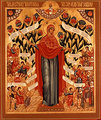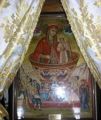Difference between revisions of "Icons of the Theotokos"
m (link) |
(→Icons) |
||
| (2 intermediate revisions by one other user not shown) | |||
| Line 2: | Line 2: | ||
==Description and symbols== | ==Description and symbols== | ||
| − | Iconographers of all times tried to show in the image of Theotokos as much beauty, gentleness, dignity and grandeur as they could imagine. They sometimes paint grief, and sometimes sorrowful, but always filled with spiritual strength | + | Iconographers of all times tried to show in the image of Theotokos as much beauty, gentleness, dignity, and grandeur as they could imagine. They sometimes paint her in grief, and sometimes sorrowful, but always filled with spiritual strength and wisdom. |
| − | The Most Pure Lady is always shown with her head covered with a veil, which drops to her shoulders, according to the tradition of Jewish women of that time. This veil or head covering is usually colored red to show her suffering and her acquired holiness. Under her veil her clothing is blue, symbolizing the humanity of the Theotokos. | + | The Most Pure Lady is always shown with her head covered with a veil, which drops to her shoulders, according to the tradition of Jewish women of that time. This veil or head covering is usually colored red to show her suffering and her acquired holiness. Under her veil, her clothing is blue, symbolizing the humanity of the Theotokos. |
| − | There are three golden stars, one on the forehead and one on each shoulder of the Most Holy Theotokos. These stars symbols of her virginity. She was a virgin before, during, and after the [[Nativity]] of Christ. The three stars are also a symbol of the [[Holy Trinity]]. Sometimes the third star is covered by the figure of the Christ Child the second person of the Holy Trinity. | + | There are three golden stars, one on the forehead and one on each shoulder of the Most Holy Theotokos. These stars are symbols of her virginity. She was a virgin before, during, and after the [[Nativity]] of Christ. The three stars are also a symbol of the [[Holy Trinity]]. Sometimes the third star is covered by the figure of the Christ Child the second person of the Holy Trinity. |
==Number of types== | ==Number of types== | ||
| Line 15: | Line 15: | ||
* All Merciful, '''Panakranta''' – In this type, Mary is regally enthroned with Baby Jesus on her lap, both facing the viewer. The throne symbolizes her royal glory, she alone is perfect among those born on earth. According to the [[Fourth Ecumenical Council]], she presides with Christ over the destiny of the world. | * All Merciful, '''Panakranta''' – In this type, Mary is regally enthroned with Baby Jesus on her lap, both facing the viewer. The throne symbolizes her royal glory, she alone is perfect among those born on earth. According to the [[Fourth Ecumenical Council]], she presides with Christ over the destiny of the world. | ||
* Intercessor, '''Agiosortissa''' – Mary is shown alone, in profile with her hands held out in supplication. She is facing to her left, usually to a separate icon of Christ. | * Intercessor, '''Agiosortissa''' – Mary is shown alone, in profile with her hands held out in supplication. She is facing to her left, usually to a separate icon of Christ. | ||
| − | * Praying, - '''Oranta''' , Panagia , Lady of the Sign - In this type, Mary is shown with arms in ornate position, with Christ enclosed in a circle in her womb. "Of the Sign," is a reference to the words of | + | * Praying, - '''Oranta''' , Panagia , Lady of the Sign - In this type, Mary is shown with arms in ornate position, with Christ enclosed in a circle in her womb. "Of the Sign," is a reference to the words of Isaiah 7:14, "The Lord himself shall give you a sign. Behold a virgin shall conceive, and bear a son, and his name shall be called Emmanuel." |
The calendar of the [[Church of Russia|Russian Church]], where iconography of the Virgin is highly developed, mentions 260 of her icons noted for miracles and celebrated liturgically. | The calendar of the [[Church of Russia|Russian Church]], where iconography of the Virgin is highly developed, mentions 260 of her icons noted for miracles and celebrated liturgically. | ||
| Line 57: | Line 57: | ||
Image:Life_Giving_Spring.jpg|[[Panagia the Life Giving Spring|Panagia the Life Giving Spring]] | Image:Life_Giving_Spring.jpg|[[Panagia the Life Giving Spring|Panagia the Life Giving Spring]] | ||
Image:Unburnt Bush.JPG|[[Theotokos the Unburnt Bush icon|Panagia of the Unburnt Bush icon]] | Image:Unburnt Bush.JPG|[[Theotokos the Unburnt Bush icon|Panagia of the Unburnt Bush icon]] | ||
| + | File:ΠΑΝΑΓΙΑ ΕΛΕΥΘΕΡΩΤΡΙΑ.jpg|"Panagia Eleftherotria" (Our Lady of Deliverance), Kifissia, Athens, Greece. | ||
</gallery> | </gallery> | ||
Latest revision as of 17:30, April 5, 2015
Description and symbols
Iconographers of all times tried to show in the image of Theotokos as much beauty, gentleness, dignity, and grandeur as they could imagine. They sometimes paint her in grief, and sometimes sorrowful, but always filled with spiritual strength and wisdom.
The Most Pure Lady is always shown with her head covered with a veil, which drops to her shoulders, according to the tradition of Jewish women of that time. This veil or head covering is usually colored red to show her suffering and her acquired holiness. Under her veil, her clothing is blue, symbolizing the humanity of the Theotokos.
There are three golden stars, one on the forehead and one on each shoulder of the Most Holy Theotokos. These stars are symbols of her virginity. She was a virgin before, during, and after the Nativity of Christ. The three stars are also a symbol of the Holy Trinity. Sometimes the third star is covered by the figure of the Christ Child the second person of the Holy Trinity.
Number of types
There is no other subject in iconography, besides Christ, that has been painted so often and with so much love, as the image of the Theotokos. There are five main types of representation of the Theotokos in Orthodox iconography:
- The Guide; Hodigitria - In this type, the Ever Virgin Mary is holding Christ and pointing toward Him, as a guide to God and salvation.
- Tender Mercy; Eleusa - In this type, the Theotokos holds her Son, who touches his face to hers and wraps at least one arm around her neck or shoulder. The Theotokos represents the Church of Christ, thereby displaying the fullness of love between God and man, a love that can only be achieved within the bosom of church, the Mother.
- All Merciful, Panakranta – In this type, Mary is regally enthroned with Baby Jesus on her lap, both facing the viewer. The throne symbolizes her royal glory, she alone is perfect among those born on earth. According to the Fourth Ecumenical Council, she presides with Christ over the destiny of the world.
- Intercessor, Agiosortissa – Mary is shown alone, in profile with her hands held out in supplication. She is facing to her left, usually to a separate icon of Christ.
- Praying, - Oranta , Panagia , Lady of the Sign - In this type, Mary is shown with arms in ornate position, with Christ enclosed in a circle in her womb. "Of the Sign," is a reference to the words of Isaiah 7:14, "The Lord himself shall give you a sign. Behold a virgin shall conceive, and bear a son, and his name shall be called Emmanuel."
The calendar of the Russian Church, where iconography of the Virgin is highly developed, mentions 260 of her icons noted for miracles and celebrated liturgically. The Menaion of Sergius numbers the designations of Most Holy Theotokos icons at 700.
History
The tradition attributes St. Luke with painting the first icons of the Theotokos. We know of three types he painted: "Umilenie" (Our Lady of Tenderness), "Hodigitria" (She who leads the way), and a third type, of her without a child or praying to the Christ child. (The facts of the third type are confused).
Icons
Panagia tou Harou (Leipsi island, Greece)
Kursk Root of the Theotokos (Oranta)
Theotokos of Tikhvin (Hodigitria)
Theotokos of Vladimir (Eleusa)
Panagia Pantanassa of Mystra, Greece
Panagia Paramythea of Vatopaidi Monastery, Mt Athos
Theotokos of the Passion (Hodigitria)
Panagia Phaneromene, Chiliomodi (Corinth, Greece)
Panagia Portaitissa (Hodigitria)
Panagia Tricherousa, Our Lady with the Three Hands
Source
- Theology of the Icon by Leonid Ouspensky ISBN 0-88141-124-8
External link
- Icons of the Mother of God - OCA website lists icons by feast date of the icon.






















